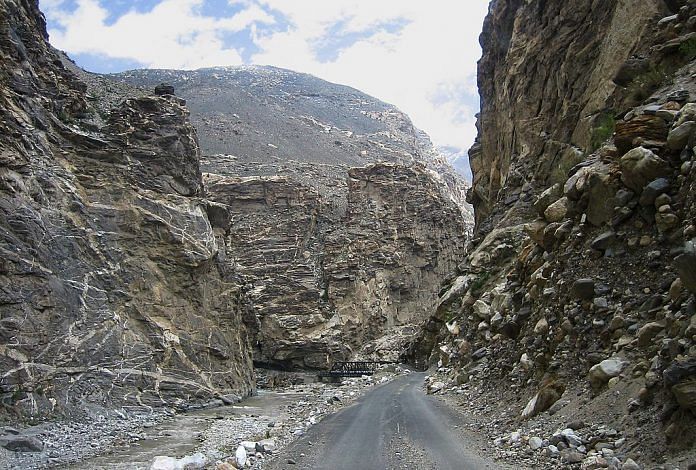Shimla: Not a single Indian trader has so far sought permits for this season’s annual bilateral trade with China through the 18,599-feet Shipki La pass in Himachal Pradesh’s Kinnaur district. The trade season begins on 1 June, when the snow melts in the upper reaches, and continues until October and November.
The traders, who head through Kinnaur district to reach the Tibetan Autonomous Region in China, have to mandatorily register with the additional district magistrate (Pooh). They are issued permits for the visit, specifically indicating their dates of travel and return.
This year, however, not a single trader has registered, with officials and other stakeholders blaming the Covid-19 pandemic in China.
“The traders are not willing to go this year due to the Covid pandemic,” Kinnaur deputy commissioner Gopal Chand told ThePrint. “I think it’s appreciable in the wake of the virus spreading. Our district did not report any case until 2 June. But now a couple returning from New Delhi have tested positive today. They have been put in institutional quarantine.” “We have conveyed the views of the traders to the director (industries), who is the nodal authority,” he added.
The development also comes amid India-China tensions along the Line of Actual Control (LAC) in Eastern Ladakh but officials and the traders themselves refuse to cite this as a reason for the decision.
“I have sent the file to the state government. The main factor is the coronavirus. The traders have cited this reason alone,” said Hans Raj Sharma, director (industries).
The traders agree.
“Our traders strongly feel that time is not congenial to undertake trade activities. It is risky and unsafe to go across into China because of the pandemic and ongoing lockdown restrictions on the Indian side,” said Hishey Negi, president of the Kinnaur Indo-China Trade Association.
“The governments, both at the state and the Centre, have also not taken any decision on allowing bilateral trade this year,“ Negi confirmed to ThePrint.
Also read: China has definitely crossed India’s Lakshman rekha but it won’t lead to 1962 again
Trade had been affected in 2017
The trade along this route, which only resumed in 1992 after it went through a 30-year ban following the 1962 India-China war, was also affected due to the Doklam stand-off in 2017.
While there was no ban in 2017, fewer traders crossed over that year. This is reflected in data with the District Industries Centre at Kinnaur. The data shows that trade worth Rs 59.21 lakh was transacted that year, down from the Rs 8.59 crore in 2016.
According to the data, this figure was Rs 7.32 crore in 2014 and Rs 9.72 crore in 2015.
Since 2017, however, it has seen a drop. In 2018, there was trade worth Rs 2.52 crore, which rose to just above Rs 3 crore in 2019.
For many of the traders, who are mostly Kinnauri tribals and Dalits, or belong to BPL families, the trade through Shipki La is a crucial means of livelihood as tourism is seasonal and farming is tough in the higher reaches.
They dabble with about 36 items on the export list and about 20 goods on the import list.
Norbu, 38, a trader from Kinnaur told ThePrint that he took the trip some eight to nine times last year and earned between Rs 20 and Rs 25 lakh in all. “There is high demand for Indian-woven carpets, shawls, blankets, local herb products, ayurvedic medicines, handloom products and stationery items,” he said.
Other items that the traders take along include rice and pulses, edible oil, agriculture implements, milk products, cigarettes, pashmina and dry fruits.
A dozen new items, including Chinese handicrafts, carpets and herbal medicines, have been included in the trade list but there is a ban on the sale of livestock — earlier there had been a demand on the Indian side for Chiku goats, horses and mules.
Dr O.C. Handa, a noted author and an expert on the ancient trade ties with Tibet, said that in the pre-and post British era up until the Indo-China war, things were fine but thereafter the bilateral trade has been largely symbolic but useful for natives of Kinnaur and Lahaul-Spiti.
The need for trade centre in Himachal
Negi, president of the Kinnaur Indo-China Trade Association, told ThePrint that he has been persistently writing to the state government and the Union Defence Ministry to set-up a trade centre at Chuppan, the last village on the Indian side, where traders from both the sides can do business.
“Lack of infrastructure on our side is the biggest handicap. Our traders travel on foot or use mules but on the Chinese side, there is quite a good infrastructure,” he said. “I have asked for the development of the last village on our side. It can be a tourist point and will also increase the volume of trade by 100 to 200 times.”
He, however, refused to be drawn into the controversy over boycotting Chinese goods.
“Our trade, as our history, relates to Tibet. We get back Tibetan handloom and handicraft products,” he said.
Also read: India waits for China’s diplomatic words to ‘translate into action on ground’ at LAC in Ladakh



